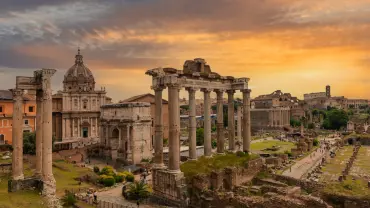The annals of history are dotted with rare individuals whose quest for knowledge has significantly shaped the course of human understanding. Among these luminaries is the Graeco-Egyptian alchemist and mystic, Zosimos of Panopolis. Sometimes known as Zosimus of Panopolis and rarely as Zozimos, his works, collectively known as the books of Zosimos, have had a lasting impact on the fields of chemistry, metallurgy, and the esoteric arts.
So, who was Zosimos of Panopolis? We’re here to find out, with an exploration of what is known about his life, his work and the world of alchemy.
The life of Zosimos of Panopolis

Alexandria, Egypt (Credit: Universal History Archive/Universal Images Group via Getty Images)
The details of the life of Zosimos of Panopolis, including where and when he lived, remain subjects of scholarly debate. Even his name is not entirely agreed upon, with variations including Zosimus of Panopolis and Zozimos.
The general consensus is that Zosimos was from Panopolis, now Akhmim in Egypt, and that he was working sometime around 300 AD. However, he’s also linked to Alexandria, with many sources claiming he lived there and one – the 10th-century Byzantine encyclopaedia known as The Suda – that states he was born there. As for his lifespan, this can only roughly be said as being during the late 3rd and early 4th centuries AD. Nothing else is known of Zosimos or Zosimus of Panopolis, although some speculate he was a teacher.
Yet, even with these uncertainties, Zosimos is the earliest alchemist about whom there’s any substantive historical information. He’s also the author of one of the earliest accounts of the practice. All of which rather raises the question, what is alchemy?
The Aims of Alchemy

Antique pharmacy bottles, typically used for alchemy. (Credit: Oliver Helbig via Getty Images)
To appreciate Zosimos’s contributions, it’s essential to grasp the basic tenets and aims of alchemy. Alchemy was a school of thought that blended elements of chemistry, metallurgy, philosophy, and mysticism. As for its pursuits, these were, in a word, ambitious. They included a universal cure for diseases, achieving immortality, and attaining ultimate wisdom. Oh, and making gold. Specifically, changing the form of “base” metals like copper and lead into “noble” metals, especially gold. This was known as “transmutation.”
Alchemy was rooted in the belief that, through a combination of scientific experimentation and spiritual insight, one could uncover the fundamental principles of the universe. Its practitioners sought not only material transformation but also spiritual enlightenment, reflecting a holistic view of the world where matter and spirit were interconnected.
Different cultures around the world have developed their own forms of alchemy. However, much of the writing about early Graeco-Egyptian alchemy was destroyed, some attributing this to the Roman emperor Diocletian banning the practice and, later, the burning of the library in Alexandria. Zosimos of Panopolis is credited with preserving and cataloguing a great deal of information that would otherwise have been lost.
The Books of Zosimos

An old manuscript book (Credit: BlackQuetzal via Getty Images)
Zosimos was prolific in his writings, and is believed to have authored an encyclopaedia of alchemy comprising 28 books. Among other things, these summarised the history of Graeco-Egyptian alchemy and the writings of others, such as Maria the Alchemist. They included pictures and diagrams of apparatus as well as recipes for metal processing. And they discussed religious doctrines, especially those of Gnosticism and Hermetism (as distinct from Hermeticism.)
However, only a fraction of the books of Zosimos remain. And those are disjointed sections and fragments of his works. To make matters more complicated, what’s left is replete with ambiguity. For instance, some of his writings are correspondences. There are chapters addressed to people named Eusebia and Theodore, but it’s unclear who they were. In some cases, there’s doubt over whether they were even real people or fictional constructs. Also, a significant portion of his writings were descriptions of his dreams and visions. Added to this was his complicated view of secrecy and whether alchemy should be known by the masses, which led him to use symbols and codes.
Even so, the remnants of the books of Zosimos offer significant insights into the early practice of alchemy in this corner of the world. He detailed the works of his predecessors as well as his own, laying foundational concepts and methodologies that influenced later alchemical traditions. It’s often said that, without Zosimos, there would be next to no knowledge of earlier practices.
The Ideas and Methods of Zosimos

Photography of the four elements (earth, water, air, fire) in water glasses. (Credit: ThomasVogel via Getty Images)
There are myriad facets to Zosimos’s work. From his fascination with the interaction of vapours and solids to his exploration of the divine, his areas of interest are wide and varied, including:
Transmutation
Material conversion of metals was a central aspect of the work of Zosimus. He focused on turning what he called the “Four Metals” of lead, copper, tin and iron into silver and gold. However, in reality, what he did was create tinted metal alloys that resembled the colour of gold. He may have even considered these better than the real thing, as some were even yellower. As part of this, Zosimos showed particular interest in how vapours interact with solids, drawing on observations from ancient craftsmanship, such as the use of cadmia vapours to turn copper into brass, or mercury and arsenic vapours to give copper a silvery appearance.
The Four Elements
The elements of fire, water, earth and air were at the heart of the work and were included within the books of Zosimos. He believed they formed a part of everything and argued, for example, that the elements in base metals could be reformulated, thus changing the nature of the metals.
Methodology and Apparatus
Zosimos was dedicated to practical challenges and seeking solutions through both experimentation and theoretical principles. He was a firm believer in the value of quality equipment and detailed a range of apparatuses for alchemical processes, such as sublimation and filtration. One of the most significant of these contributions was his account of the distillation process developed by Maria the Alchemist.
Vapours and Solids
Zosimos’s experiments were guided by theoretical principles, with his observations refining his theoretical understanding. Many even credit Zosimos’s texts as being among the earliest to describe chemical reactions and apparatus which helped to form the basis of modern chemistry.
Mysticism
One of the most complex aspects of Zosimos is the seemingly antithetical nature of his beliefs. So far, much of what we’ve seen of his work was scientific in nature. But Zosimos was profoundly influenced by concepts of mysticism, philosophy, and the link between the spiritual and material worlds. And, given his influence in the world of alchemy, Zosimos has been credited with solidifying the central role of the spiritual and mystical within the practice.
As well as the transformation of metals, he was also interested in transforming the human spirit or “pneuma,” allowing for the attainment of perfect knowledge or “Gnosis,” and thus ascent to the divine. He believed in demons and cautioned they could interfere with alchemical experiments. He referenced the Hermetic Corpus and cited Gnostic doctrines such as that there is a piece of God, known as a “divine spark” in everyone that one must locate.
What Happened to Zosimos?

A fictional alchemist working in his laboratory. (Credit: aluxum via Getty Images)
Details about the later life and death of Zosimos are scarce, as historical records primarily focused on his contributions to alchemy rather than his actual life. Beyond his work, little is known about the story of Zosimos, and his family life and time of death are not recorded. His legacy, however, is well-documented through his profound influence on alchemy, blending scientific experimentation with mystical and philosophical insights.
Zosimos of Panopolis: An enduring legacy

Scene of a alchemist’s laboratory. (Credit: Studio-Annika via Getty Images)
Zosimos’s influence extended far beyond his own time, making him an enduring figure in the history of science and mysticism. His works, though fragmented, continue to be studied for their contributions to the early development of alchemy, chemistry, and their underlying philosophical questions.












